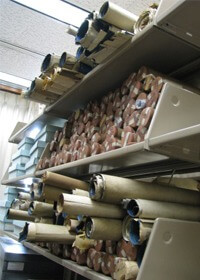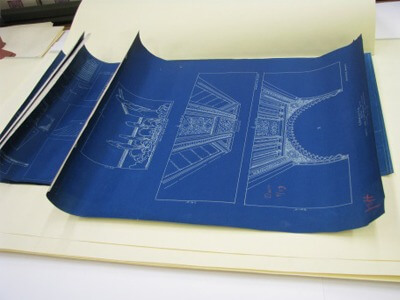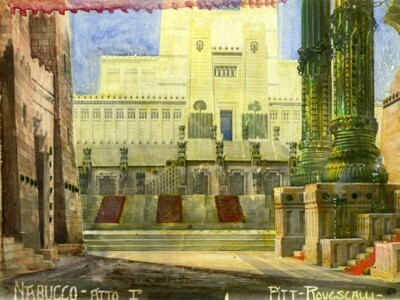By Annie Oelschlager and Tiffany Arnold
 The Historic Scenic Collection, held in Rare Books and Special Collections at Northern Illinois University’s Founders Memorial Library, contains intriguing documentation, photos, blueprints, and advertisements of the Chicago Lyric Opera dating back to the early 1900s. This collection is an amazing 163 linear feet of materials, spanning an entire century of theatre performances. Highlights from the collection processed so far include glamorous production photos of scenes and actors, blueprints for the sets and stages, and contemporary programs handed out to avid theatre goers.
The Historic Scenic Collection, held in Rare Books and Special Collections at Northern Illinois University’s Founders Memorial Library, contains intriguing documentation, photos, blueprints, and advertisements of the Chicago Lyric Opera dating back to the early 1900s. This collection is an amazing 163 linear feet of materials, spanning an entire century of theatre performances. Highlights from the collection processed so far include glamorous production photos of scenes and actors, blueprints for the sets and stages, and contemporary programs handed out to avid theatre goers.
One of the more challenging parts of processing this collection has been the flattening of delicate rolled-up blueprints. We constructed our own humidification chamber using two sterile refuse cans (one 20 gallon and one 44 gallon) with one layered inside the other. The innermost can has holes drilled into it and we place a mixture of water and concentrated Lysol (to keep mold from growing) in the bottom of our outermost container. We then place the blueprints inside the inner chamber and seal it with a lid adhered to blotter paper, which sucks up any excess moisture so that the blueprints won’t be damaged. We kept them inside this chamber for about a week, periodically checking on their progress, until they were loosened enough to be taken out and flattened between two pieces of blotter paper with weighted glass placed on top and left to dry for about four days.
 Once flattened and dry, we placed them inside special nonreactive folders appropriate for long-term storage. These prints have fascinating notations on them left behind by the project engineers that created them, which makes them especially rewarding to conserve.
Once flattened and dry, we placed them inside special nonreactive folders appropriate for long-term storage. These prints have fascinating notations on them left behind by the project engineers that created them, which makes them especially rewarding to conserve.
The Historic Scenic Collection also contains a group of reference materials, mostly resources that both costume and set designers used for inspiration or accuracy. Among these are books and magazines containing material swatches, tapestry motifs, and ornate wood depictions, as well as periodicals and catalogues from which the Chicago Opera often ordered items for their productions.
 All the captivating photographic documentation that this collection offers has now also been properly processed and placed into safe acid free containers and plastic sleeves. This painstaking endeavor is well worth the time and effort in the access to a unique period in Chicago’s artistic history that we can provide to our patrons. We are soon going to complete processing the main parts of this collection and will continue to work on unfolding the blueprints. Come by the Rare Books department at NIU to see this remarkable collection!
All the captivating photographic documentation that this collection offers has now also been properly processed and placed into safe acid free containers and plastic sleeves. This painstaking endeavor is well worth the time and effort in the access to a unique period in Chicago’s artistic history that we can provide to our patrons. We are soon going to complete processing the main parts of this collection and will continue to work on unfolding the blueprints. Come by the Rare Books department at NIU to see this remarkable collection!
This article was originally published in Founder’s Type, the newsletter of the Friends of NIU Libraries. Annie Oelschlager is a manuscripts processor for NIU Libraries, and Tiffany Arnold works as a graduate assistant.
